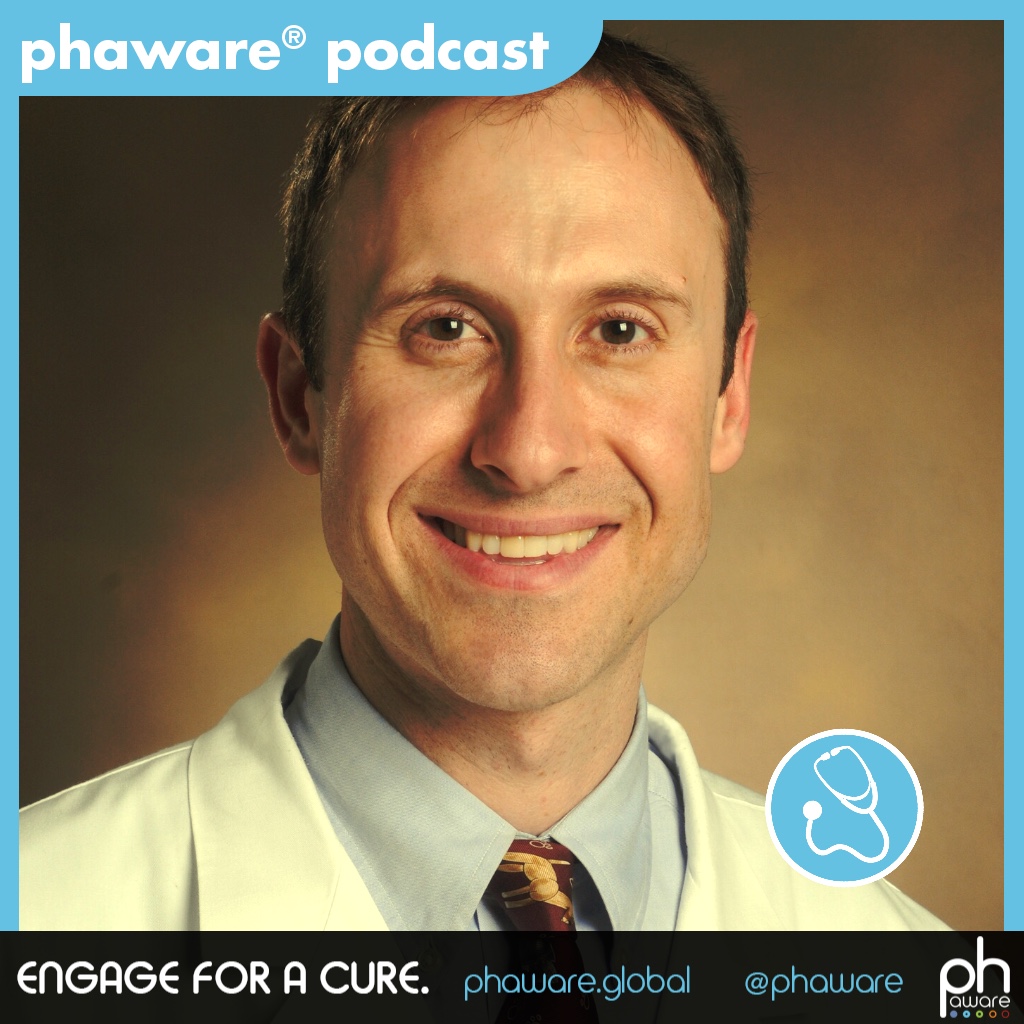Phaware Podcast: Eric Austin, MD (Part 2 of 3)

This podcast series, created and produced by phaware, is being offered as a regular guest feature on Pulmonary Hypertension News to bring the voices and life experiences of PH patients, family members, caregivers, healthcare specialists, and others to our readers. You may listen to the podcast directly, or read it via the transcript below.
I’m Aware That I’m Rare: Eric Austin, MD MSCI
The phaware® interview (Episode 117)
Eric Austin is the Director of the Vanderbilt Pediatric Pulmonary Hypertension (PH) Program at Vanderbilt University Medical Center’s Monroe Carell Jr. Children’s Hospital, where he treats individuals with pulmonary hypertension and other pulmonary vascular diseases. He is also a member of the adult program’s Vanderbilt Pulmonary Hypertension Clinical and Research Program, with whom he leads and/or participates in various translational research studies.
Hello. I’m Eric Austin. I’m the director of the Pulmonary Vascular Disease Program at the Vanderbilt Children’s Hospital here in Nashville, Tennessee.
Today, I’d like to go a little bit deeper into screening for pulmonary hypertension and early diagnosis with a focus on individuals who have lung disease associated with  prematurity or other conditions of childhood.
prematurity or other conditions of childhood.
Two obvious areas that we’ll expand upon in the rest of our discussion here would be genetic testing and the use of an echocardiogram and/or electrocardiogram. Let’s think about high-risk groups that we might apply these technologies to.
I like to think about different organ systems involved that would put people at risk, and also different points in people’s lifetime. I’m a pediatric pulmonary hypertension doctor and pulmonologist, and so one of the things that I think a lot about is developmental lung diseases. This could include congenital diaphragmatic hernia, alveolar capillary dysplasia with or without misalignment on the pulmonary veins, lung hypoplasia or underdevelopment, surfactant protein abnormalities, abnormalities of the pulmonary alveolar function including pulmonary proteinosis, and pulmonary lymphatic problems.
All of these conditions could be associated with pulmonary hypertension at some point in their development or expression or even after they’ve been dealt with. You can see pulmonary hypertension emerge if they’ve not been completely handled. A reasonable approach if you have a person who has one of these diagnoses, and especially if they have a diagnosis of prematurity, which we’ll touch on even more, would be to get an echocardiogram and probably a BNP, which is a brain natriuretic peptide, or NT-proBNP, level at the time that you first determined that the individual has some sort of lung disease that concerns you.
The time of diagnosis, for example, in congenital diaphragmatic hernia, actually often occurs in utero before birth. At the time of birth, we usually very quickly perform an echocardiogram of those individuals, because almost all of them by definition have pulmonary hypertension at the time of birth, but we also want to watch them over time. I think about not just an initial screening, but also a serial screening as clinically indicated. At the bare minimum for a person who has, for example, lung hypoplasia or congenital diaphragmatic hernia that’s been dealt with and has been felt to be under control, we would do serial screening for pulmonary hypertension every one to two years.
Then, of course, as clinically indicated, if they have a profound illness or a setback, that would suggest that they have pulmonary hypertension developing. I’ve touched on it earlier, but a very large group at risk of pulmonary hypertension relative to the rare disease that we’re talking about would be those individuals born prematurely. There have been a number of recent studies to think about the premature infant and their risk of the development of pulmonary hypertension. For example, Pete Mourani and colleagues at the University of Colorado, Steve Adman and Dunbar Ivy, and others embarked on a study not long ago in which they looked at 316 individuals enrolled in a study of prematurity and pulmonary hypertension.
They focused on people born less than 34 weeks gestation and also between 500 and 1,250 grams at the time of birth, so we’re talking pretty small kids. What they did is they performed echos at 7 days of age, and then they performed echos at 36 weeks predicted post-menstrual age. These would be, if you’re born at say 24 weeks gestation, you would get an echocardiogram at 7 days of age or one week, and then you would get an echo at 12 weeks later, which was 36 weeks post-menstrual age, we call it.
The investigators at the University of Colorado, who also worked with a group in Indiana University, Riley Children’s found that of the 316 patients enrolled at 7 days of age, 42% actually had pulmonary hypertension versus 58% without pulmonary hypertension. As you can see, a really large degree of individuals using echocardiogram criteria had evidence of pulmonary hypertension at 7 days of life. Intriguingly, if you follow those children out, about 80% of the children with pulmonary hypertension at one week of age had no pulmonary hypertension by the time they were 36 weeks.
Of course, that means about 20% still had pulmonary hypertension at 36 weeks. In contrast, about 10% of the kids who had no pulmonary hypertension at 7 days subsequently had pulmonary hypertension at 36 weeks post-menstrual age. Thirty-six weeks was chosen because that’s a common time at which we determine there’s a diagnosis of the presence or absence of a concurrent condition called bronchopulmonary dysplasia, or BPD, which is lung disease of prematurity, essentially. What was interesting about that study, in addition to what I told you, was that for those babies who had BPD, or bronchopulmonary dysplasia, present and felt to be severe based upon a series of criteria that have been previously agreed upon, … 30% of those patients, and there were 65 children in that category, had the presence of pulmonary hypertension by echocardiogram at 36 weeks. What that tells us was what we already anticipated, is that those individuals with the most severity of lung disease born in premature birth are at the highest risk of developing pulmonary hypertension. You could imagine a concept that you would want to focus your early echocardiographic analysis of the formerly premature infant on those people felt to have severe lung disease following delivery.
One way to think about diagnosing pulmonary hypertension or screening for pulmonary hypertension among those who have premature lung disease was to say, OK, at 36 weeks, we’re going to screen all of our patients for pulmonary hypertension no matter what their condition is. Or we’re going to take a severity basis approach, we’re going to look at how much oxygen do they need, how poor is their growth, what are the concurrent conditions they’re struggling with, do they have an atrial septal defect, if they had intraventricular hemorrhage, or have they had illness of their bowels. There’s a variety of ways that you can think about how to approach BPD screening for pulmonary hypertension.
No matter what you do, you got to know that about 12% to 28% of people who had BPD at 36 weeks are going to get diagnosed with pulmonary hypertension. If you’re a severe BPD patient, you’re along that 28% to 30% rate and much more likely. What we do in Vanderbilt, and most people I think do nationally right now, is for those individuals or infants with established BPD in the [inaudible] neonatal ICU, or even those who’ve gone home, we obtain serial cardiograms with or without BNP measures every four to six months, and then on an as-needed basis. Now, the caveats to that are that you need to be careful, because the echocardiogram as we mentioned earlier is a non-invasive study, and so it may underestimate the presence of PH.
There are also times when it’s overestimating the presence of pulmonary hypertension, so I like to add an electrocardiogram if I have any degree of confusion. Of course, we certainly consider the need for a cardiac catheterization in each individual diagnosed with pulmonary hypertension. In the pediatric population, there may be times that we feel the risk of cardiac catheterization for the BPD infant does not outweigh the benefit, and so we weigh each of those cases very carefully. The other thing to keep in mind is that some children will look “normal” by echocardiogram when they’re “healthy,” but then can have a profound setback at the time of a respiratory illness such bronchiolitis or other respiratory condition.
It is important to remember that there are individuals born prematurely who are never diagnosed with BPD or bronchopulmonary dysplasia. In that setting, we’re certainly a little less likely to screen by echocardiogram for pulmonary hypertension. In general, we typically do screen all individuals at our institution, whether or not they have the diagnosis of BPD, with the screening of echocardiogram at 36 weeks post-menstrual age, and then we consider its repeat of echocardiogram as clinically indicated over time. When you think about the at-risk individual, there are other conditions that certainly we want to think about, and we’ll discuss several of those right now. One of those would include the population of individuals who have chronic hemolytic anemias.
The most common example would be the sickle cell lung disease population. While there’s limited pediatric evidence to determine exactly when you would approach screening for those individuals, we generally recommend the screening echocardiogram at 8 years of age, and then every one to two years thereafter and as needed clinically. For the individual who has a diagnosis in pediatrics of HHT, or hereditary hemorrhagic telangiectasia, you’re probably aware that they associate with gene mutations in either the ALK1 or ACVR1 gene or the endoglin gene.
Then, for those individuals, we see those people in our pulmonary vascular disease clinic when they do not have a diagnosis of pulmonary hypertension on a yearly basis, and we obtain echocardiograms on a yearly basis at that time. We certainly also see them as needed and will have a low threshold to obtain an echocardiogram should there be challenges, because we know that HHT associates with pulmonary arterial hypertension in a minority of cases.
Down syndrome is a large burden of challenge in our pediatric pulmonary hypertension clinics, because these children are more at risk to develop pulmonary hypertension than the average individual. Particularly those children who have had Down syndrome associated with congenital heart disease or Down syndrome associated with sleep disturbances, we’re very aggressive about screening echocardiograms in those individuals. If you have an individual who’s had Down syndrome who is well, thankfully, over time and did not require a large amount of intensive medical care, when they come to us at some point in their childhood, I will get a screening echocardiogram at 8 years of age if they’d not have one previously. However, if they have sleep-disordered breathing and had not had an echocardiogram already, I will obtain an echocardiogram in those children and, of course, those children who have had congenital heart disease who have had echocardiograms all along. If it’s a remote repair of a congenital heart disease in a patient who has Down syndrome, we’ll say, for example, a congenital heart disease repaired at age 4 and not been well-integrated to the medical community after that, I’ll obtain an echocardiogram, again, at 8 years of age and then as needed.
One of the other populations we’ll see pulmonary vascular disease in is those individuals who have liver disease. In that circumstance, we’ll recommend a screening echocardiogram at the time of diagnosis of their disease and at the time of their liver transplant evaluation as well as a yearly screening for those individuals who are struggling in any way. Certainly, we’re worried about not only portopulmonary hypertension in those children, but also hepatopulmonary syndrome, which are two different conditions of pulmonary vascular disease in the pediatric and adult population and people who have liver disease.
Finally, in pediatrics, we don’t have a lot of connective tissue disease associated with pulmonary hypertension, fortunately. Although, in our older children, we do see it. Certainly, as you know, in the adult population, there’s a lot of connective tissue associated with pulmonary hypertension. For the children with connective tissue disease, we recommend a yearly screening echocardiogram to occur at the time of diagnosis and then once a year thereafter, and obtaining the BNP +/- an echocardiogram as clinical conditions dictate. The other thing to keep in mind and as an additional study that I find helpful for children who are worried about pulmonary vascular and if they’re able to do it, I like to obtain lung volumes and DLCO at the time of diagnosis and on a yearly basis at least for our connective tissue disease and chronic hemolytic anemia patients as well as our liver disease individuals.
My name is Eric Austin and I’m aware that I’m rare.
EVERYBODY HAS A STORY. WHAT’S YOURS?
Phaware global association wants to share your pulmonary hypertension story with their engaged global audience. Whether you are a patient, caregiver, or medical professional, they are enlisting PH community members from around the world. Visit www.phawarepodcast.libsyn.com/contact to share your story and to be considered for a future episode. Never miss an episode with the phaware® podcast app. Learn more about pulmonary hypertension at www.phaware.global. #phaware
Note: Pulmonary Hypertension News is strictly a news and information website about the disease. It does not provide medical advice, diagnosis, or treatment. This content is not intended to be a substitute for professional medical advice, diagnosis, or treatment. Always seek the advice of your physician or other qualified health provider with any questions you may have regarding a medical condition. Never disregard professional medical advice or delay in seeking it because of something you have read on this website. The opinions expressed in this column are not those of Pulmonary Hypertension News or its parent company, Bionews Services, and are intended to spark discussion about issues pertaining to pulmonary hypertension.










Leave a comment
Fill in the required fields to post. Your email address will not be published.